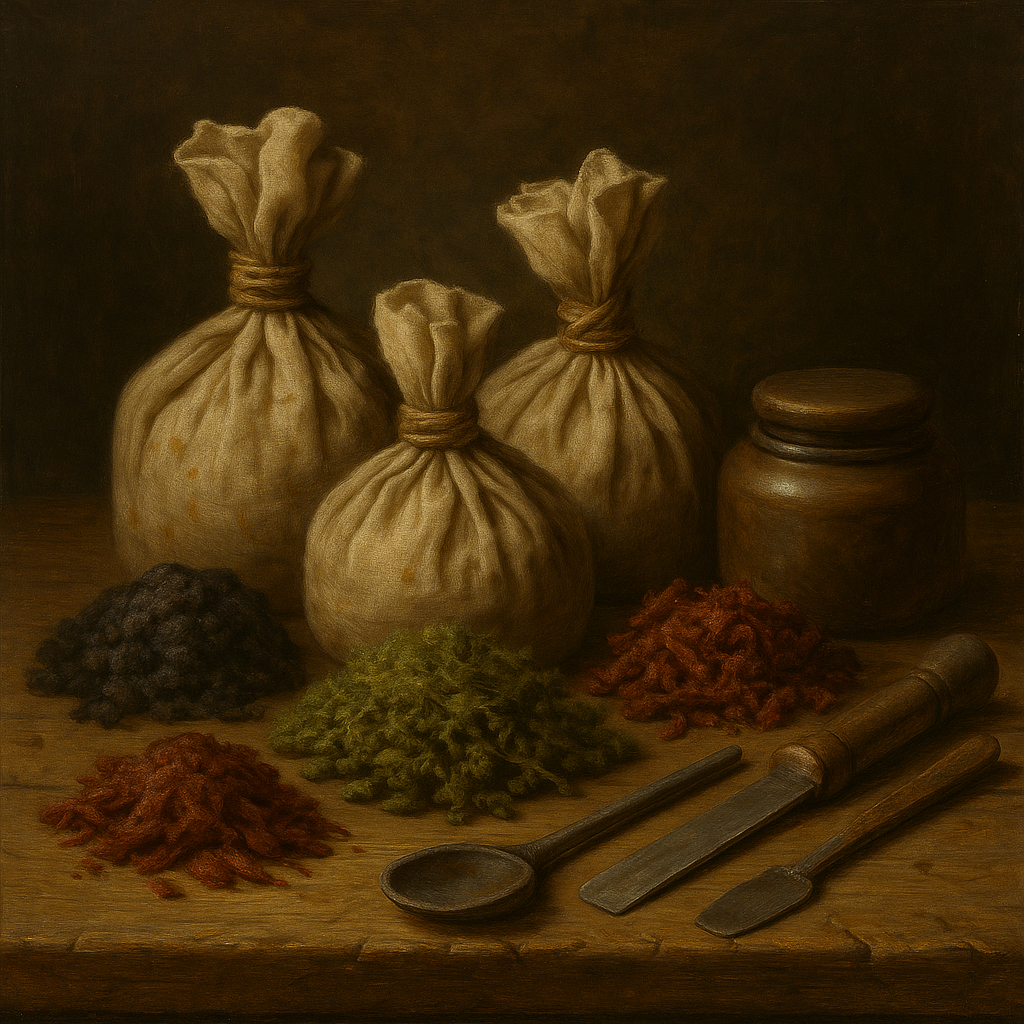Poultices
"Smear it thick, wrap it tight, and pray the moon's in the right phase." -Old alchemist's proverb, etched into the back of a tin salve lid.
In the murky borderland between medicine and myth, poultices remain one of Everwealth's most widely used, least understood, and frequently fatal remedies. At first glance, they seem harmless, a bundle of crushed herbs, bonepowder, or fermented fungus, bound in bark or cloth and slapped onto a wound with the urgency of a drowning man reaching for driftwood. But beneath that simple exterior lies a world of whispered recipes, corpse-harvested reagents, and magick-touched decay. A poultice might save your leg, or cause it to bloom with mosslike lesions that whisper in your sleep. Everything depends on the maker's intent, the tools at hand, and the alignment of forces few dare to name.Mechanics & Inner Workings
At its core, a poultice is a reactive patch, a blend of biological and alchemical agents activated through body heat, moonlight, breath, or pressure. The ingredients interact on a magickal-chemical level, seeping into wounds to fight infection, stimulate clotting, reduce fever, or dull pain. However, these effects often come with side-consequences: skin hardening, nerve-tingling, mild hallucinations, or spiritual bleed-through from misaligned magickal threads.
Manufacturing process
- Selection of herbs, minerals, and biological matter aligned with the patient’s ailment and humoral imbalance.
- Crushing and infusion using spit, spiritvine extract, or phasewater.
- Binding the mixture in treated cloth (soaked in vinegar, wax, or ritual smoke).
- Magickal Alignment, if needed, through whispered prayer or arcane ink inscribed upon the wrapping.
- Application must occur within a set window (often no more than three days from preparation, or immediately if fresh).
History
First recorded use dates back to the Scab War of the Pre-Schism Frontier, where battlefield surgeons packed wounds with clay, myrrh-sap, and powdered Throatbloom Flowers; Though the practice then was born of desperation, recorded in many texts as 'reverting to the old ways', having to 'resort' to a practice from utter lack of alternatives to what most today consider the upper echelon of modern medicine. Folk healers, unable to access clean water or divine aid, began crafting localized blends using wild reagents, sometimes copying the scent or signature of older cures without knowing the intent. Recipes were passed down orally or tattooed onto skin. The Scholar's Guild only began documenting them formally in the last century, often too late to identify which ones were lethal.
Significance
Poultices embody the Everwealthy struggle for survival: resourceful, crude, and dangerously effective. They are the people's medicine, passed through dirty hands and desperate hearts. Some cults believe the act of binding flesh with living herbs pleases nature spirits. Others see it as defiance, a refusal to die without kicking and screaming.
Creation Date
Unknown. Poultices predate most known healing practices; exact origin lost to time.
Destruction Date
Not applicable; though many ancient blends are no longer made due to ingredient extinction or moral taboos.
Rarity
Common in theory; reliable or safe variants are rare. True master-poultices, those without side effects, are considered lost knowledge.
Weight
Typically 0.1 to 0.3 lbs per application, though bulkier poultices such as insulating frostbite wraps can weigh up to 1 lb.
Dimensions
Roughly hand-sized, or cut to match the injury. Common format is a 4x4 inch patch, but warband poultices can be over a foot long.
Base Price
Anywhere from 1 Capra thorn to 100 (the equivalent of a month's stay at the average Inn, depending on ingredients and region. Rare blends command upwards of 1 gold capra or the trade of a memory.
Raw materials & Components
Common ingredients include:
- Lumeweave Moss: anesthetic and fever-reducer, but can induce voice-mimicking dreams.
- Rotbloom Pulp: closes wounds rapidly; may cause thorny skin growth.
- Blackglass Dust: fever suppressant; stains veins black.
- Red moss: blood-thickener; mildly flammable.
- Crushed Marrowtoads: magickal conductor; risk of death rebound if harvested improperly.
Tools
- Mortar and pestle (often made of bone, stone, or hardened bog-iron).
- Binding cloth or magick-infused paper.
- Ritual tongs for cursed poultices.
- Alchemical knife to bleed reagents.



Comments